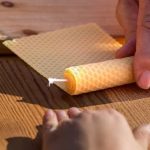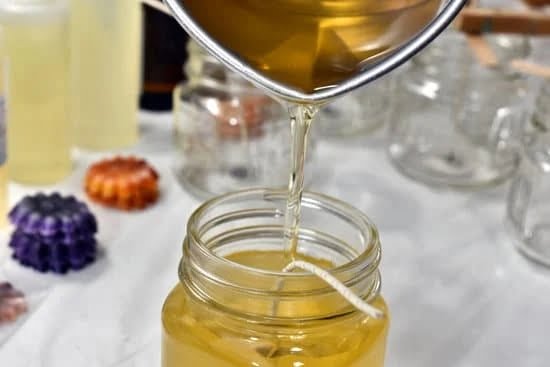Are you looking for a fun and creative activity to do with your kids? Look no further than making candles with kids. Not only is it an enjoyable way to spend quality time together, but it also offers a range of benefits for both children and adults. From fostering creativity and imagination to teaching important skills like patience and following instructions, candle-making can be a rewarding experience for the whole family.
One of the key advantages of making candles with kids is the opportunity to bond over a shared project. Working together to create something beautiful can strengthen relationships and create lasting memories. Additionally, engaging in arts and crafts activities like candle-making can help children develop their fine motor skills, boost self-esteem, and improve concentration.
In this article, we will explore the various benefits of making candles with kids, as well as provide tips on how to ensure a safe candle-making experience. From choosing the right supplies to adding fragrance and color, we will guide you through the process of creating beautiful and unique candles that your family will cherish. So gather your little ones, roll up your sleeves, and get ready to embark on a fun-filled adventure in candle-making.
Safety First
Parental Supervision
When making candles with kids, it is crucial to have proper parental supervision at all times. Children should never handle hot wax or sharp objects on their own. Adults should oversee the entire process, from gathering supplies to pouring the wax into molds. By closely monitoring the activity, parents can ensure a safe and enjoyable candle-making experience for everyone involved.
Proper Attire and Workspace
Before starting the candle-making process, make sure that children are dressed appropriately in long sleeves and closed-toe shoes to prevent any accidents or burns. Additionally, designate a clean and clutter-free workspace for the activity. Keep flammable materials away from heat sources and have a fire extinguisher nearby just in case. Creating a safe environment will help prevent any potential hazards during the candle-making session.
Educate Kids on Candle Safety
Take this opportunity to educate children about fire safety and proper handling of candles. Teach them how to safely light and extinguish candles, as well as how to recognize signs of overheating or other dangers. By instilling these important lessons early on, kids can develop a greater appreciation for the art of candle-making while also learning valuable safety skills that will benefit them in the future.
By following these tips for a safe candle-making experience, parents can create lasting memories with their kids while teaching them important lessons about creativity, responsibility, and safety awareness. Making candles with kids can be a fun and rewarding activity that fosters bonding and encourages imagination in a secure environment. Remember that safety always comes first when engaging in this hands-on craft with young ones.
Getting Started
When it comes to making candles with kids, getting started is an exciting step that sets the tone for a fun and creative experience. Before diving into the candle-making process, it’s important to gather all the necessary supplies and set up your workspace for a smooth and enjoyable activity. Here are some tips to help you get started on the right foot.
Gathering Supplies
The first step in making candles with kids is to gather all the supplies you will need for the project. This includes wax, wicks, fragrance oils, colorants, a double boiler or microwave-safe container for melting wax, a thermometer, stirring utensils, and any molds or containers for shaping the candles. Depending on the age of the children participating, you may also want to have adult supervision and safety gear like gloves and goggles on hand.
Setting Up
Create a designated workspace where you can safely make candles with kids without any distractions. Cover surfaces with newspaper or a disposable tablecloth to catch any spills or drips. Make sure there is enough lighting in the area so everyone can see what they are doing clearly.
Lay out all the supplies in an organized manner so that they are easily accessible during the candle-making process. Assign tasks to each child based on their age and ability level to keep them engaged and involved in the activity.
Tips for Success
To ensure a successful candle-making session with kids, consider using pre-measured wax flakes or blocks to eliminate the need for precise measurements that can be tricky for little hands. Keep safety as a top priority by explaining the importance of following instructions carefully and handling hot wax with caution.
Encourage creativity by providing different fragrance options and colors for them to choose from when customizing their candles. With these tips in mind, you are now ready to embark on an exciting journey of making beautiful candles with kids that they will cherish for years to come.
Choosing the Right Wax
When it comes to making candles with kids, choosing the right wax is a crucial step in ensuring a successful and enjoyable candle-making experience. There are several types of wax available, each with its own unique characteristics and benefits. Here are some common types of wax used in candle making:
- Paraffin Wax: Paraffin wax is one of the most commonly used waxes in candle making. It is easy to work with, holds color and fragrance well, and produces a smooth finish.
- Soy Wax: Soy wax is a natural alternative to paraffin wax and is derived from soybean oil. It burns cleaner and slower than paraffin wax, making it a popular choice for eco-conscious candle makers.
- Beeswax: Beeswax is another natural option that offers a sweet honey scent when burned. It has a high melting point, which can make it more challenging to work with, but the results are beautiful and long-lasting candles.
Understanding the differences between these waxes can help you choose the best option for your candle-making project with kids. Depending on your preferences for scent throw, burn time, and eco-friendliness, you can select the wax that aligns with your priorities.
In addition to selecting the right type of wax, it’s also essential to consider other factors such as the melting point of the wax, its compatibility with dyes and fragrances, and whether it requires any special handling or equipment. By involving kids in this decision-making process and explaining the differences between waxes, you can educate them about the craft of candle making while promoting their creativity and independence.
Adding Fragrance
Another option for adding fragrance to your candles is using natural ingredients like dried flowers, herbs, or spices. These can not only provide a unique scent but also add visual interest to your homemade candles.
For example, you can experiment with using lavender buds for a calming effect or cinnamon sticks for a warm and cozy scent. Just be sure to strain out any solid ingredients before pouring the wax to prevent them from catching fire when the candle is lit.
When making scented candles with kids, it’s important to consider any allergies or sensitivities they may have to certain scents. Opt for mild and non-irritating fragrances that are safe for children, such as vanilla, citrus, or chamomile.
You can also involve them in the process of choosing and mixing scents to create their own signature candle blends. By incorporating fragrance into your candle-making activities, you can engage all their senses and make the experience even more enjoyable and memorable for everyone involved.
Adding Color
One popular option for coloring candles is using liquid candle dyes, which are highly concentrated and come in a wide range of colors. These dyes can be easily mixed into melted wax to create custom shades and hues. Another fun idea for adding color is using crayons – simply melt the crayon along with the wax to achieve an array of bright colors. This method is safe and easy for children to handle under adult supervision.
To create multi-colored or layered candles, you can pour different colored layers of melted wax into the mold one by one. This technique allows for unique designs and patterns that children will enjoy creating. Additionally, experimenting with swirls or marbling effects by gently swirling different colored waxes together before they set can result in stunning visual effects in the finished candles.
| Benefits of Adding Color to Candles | Examples of Coloring Methods |
|---|---|
| Personalizes candles | Liquid candle dyes |
| Makes the candle-making experience fun | Crayons for melting |
| Allows for creative designs and patterns | Layering different colors |
Creative Designs
When making candles with kids, one of the most enjoyable aspects is getting creative with DIY candle molds and shapes. Choosing unique designs can add an extra element of fun to the candle-making process and allows children to express their creativity. There are various ways to create custom molds for candles, whether using everyday household items or purchasing specialized supplies.
One simple yet effective method for DIY candle molds is using silicone baking molds. These flexible molds come in a variety of shapes and sizes, making them perfect for creating candles in fun designs like animals, flowers, or geometric shapes. Additionally, household items such as empty juice cartons, plastic cups, or even cookie cutters can be repurposed as molds for unique candle shapes.
For children who are more artistically inclined, hand-carving custom molds out of soapstone or plaster can provide a hands-on and engaging experience. This allows kids to design one-of-a-kind shapes that can’t be found in stores. Encouraging creativity through mold-making not only makes the candle-making process more exciting but also fosters imagination and problem-solving skills in children.
| Benefits of DIY Candle Molds | Examples of DIY Candle Molds |
|---|---|
| Encourages creativity and imagination in kids | Silicone baking molds |
| Allows for customization and unique designs | Household items like plastic cups and cookie cutters |
| Fosters problem-solving skills through hands-on activities | Hand-carved soapstone or plaster molds |
Personalized Touch
Personalizing candles with kids can be a fun and creative way to bond while creating unique pieces together. One idea for personalizing candles is to incorporate elements that are special or meaningful to each child. Whether it’s adding their favorite color, incorporating their initials, or using scents that remind them of special memories, these personalized touches can make the candle-making experience even more enjoyable.
Another way to customize candles with kids is by involving them in the design process. Letting children choose the molds, shapes, and sizes of the candles can empower their creativity and give them a sense of ownership over the final product. Additionally, encouraging them to experiment with different colors and techniques can help them develop their artistic skills while having fun in the process.
To take personalization to the next level, consider adding embellishments like glitter, dried flowers, beads, or stickers to the candles. This allows kids to put their own unique spin on each candle and create one-of-a-kind pieces that reflect their personalities and interests. By embracing creativity and individuality in candle-making activities with kids, you not only create beautiful candles but also lasting memories that they will cherish for years to come.
Tips and Tricks
When it comes to making candles with kids, there are sure to be some common issues that may arise during the candle-making process. However, with a few tips and tricks up your sleeve, you can easily troubleshoot these problems and ensure a successful candle-making experience with your little ones.
One common issue that may occur when making candles with kids is air bubbles forming in the wax. This can happen if the wax is poured too quickly or at the wrong temperature. To prevent this, make sure to pour the wax slowly and at the correct temperature recommended for the type of wax you are using. Additionally, gently tapping the sides of the container or mold after pouring can help release any trapped air bubbles.
Another common problem that may arise is uneven cooling, resulting in sinkholes or cracks in the finished candle. To avoid this, make sure to allow enough time for the candle to cool and harden completely before moving or handling it. Placing the candle in a cool, draft-free area while it sets can also help prevent uneven cooling and potential issues with the finished product.
Lastly, if you find that your candles are burning too quickly or not staying lit, it may be due to an issue with the wick size or placement. Ensure that you are using the correct wick size for the diameter of your candle and that it is centered properly before pouring the wax.
Adjusting the wick length and position as needed can help improve burn times and overall performance of your homemade candles. By keeping these tips in mind and troubleshooting common candle-making issues proactively, you can enjoy a fun and successful crafting experience with your kids.
Making candles with kids allows for wonderful bonding time while fostering creativity in both adults and children alike. Spending quality time together engaging in a hands-on activity like candle-making not only creates lasting memories but also encourages imagination and problem-solving skills in kids.
So don’t let common candle-making issues deter you from enjoying this fantastic activity with your little ones – embrace them as opportunities to learn and grow together through the art of creating beautiful candles.
Conclusion
Creating memories and bonding experiences with children is invaluable, and making candles together can be a wonderful way to do just that. Not only does the process of making candles allow for creativity and self-expression, but it also fosters collaboration, patience, and a sense of accomplishment. The joy that comes from seeing a finished candle that was made through teamwork and shared efforts is truly priceless.
The tactile experience of making candles with kids also provides an opportunity for sensory exploration and learning. From choosing the right wax to adding fragrances and colors, children can engage their senses in a hands-on way that stimulates their curiosity and imagination. Additionally, working on intricate designs or personalized touches can help develop fine motor skills and attention to detail in a fun and engaging manner.
As parents or caregivers, engaging in activities like making candles with kids not only creates lasting memories but also strengthens the bond between adults and children. Taking the time to engage in creative projects together shows children that they are valued, encourages open communication, and builds trust and mutual respect. So gather your supplies, set up your workspace, and start creating beautiful candles with kids today – the memories you make will be cherished for years to come.
Frequently Asked Questions
Can You Make Candles With Kids?
Making candles with kids can be a fun and creative activity for the whole family to enjoy. It’s a great way to spend quality time together while also teaching children about different methods and techniques of candle making.
Can You Make a Candle With Household Items?
Yes, it is possible to make a candle using household items. Items like old crayons, leftover wax from used candles, mason jars, essential oils, and even kitchen utensils can be repurposed to create unique and personalized candles. It’s a great way to reduce waste and get creative at the same time.
How Old Do You Have to Be to Make Candles?
The age at which children can safely make candles will depend on several factors such as the type of candle making method being used, the materials involved, and adult supervision. In general, older children (around 10 years old and above) may be more capable of handling hot wax and other potentially dangerous materials under guidance.
Younger children can still participate in candle making activities with non-toxic options that are safe for their age group.

Welcome to my candle making blog! In this blog, I will be sharing my tips and tricks for making candles. I will also be sharing some of my favorite recipes.





